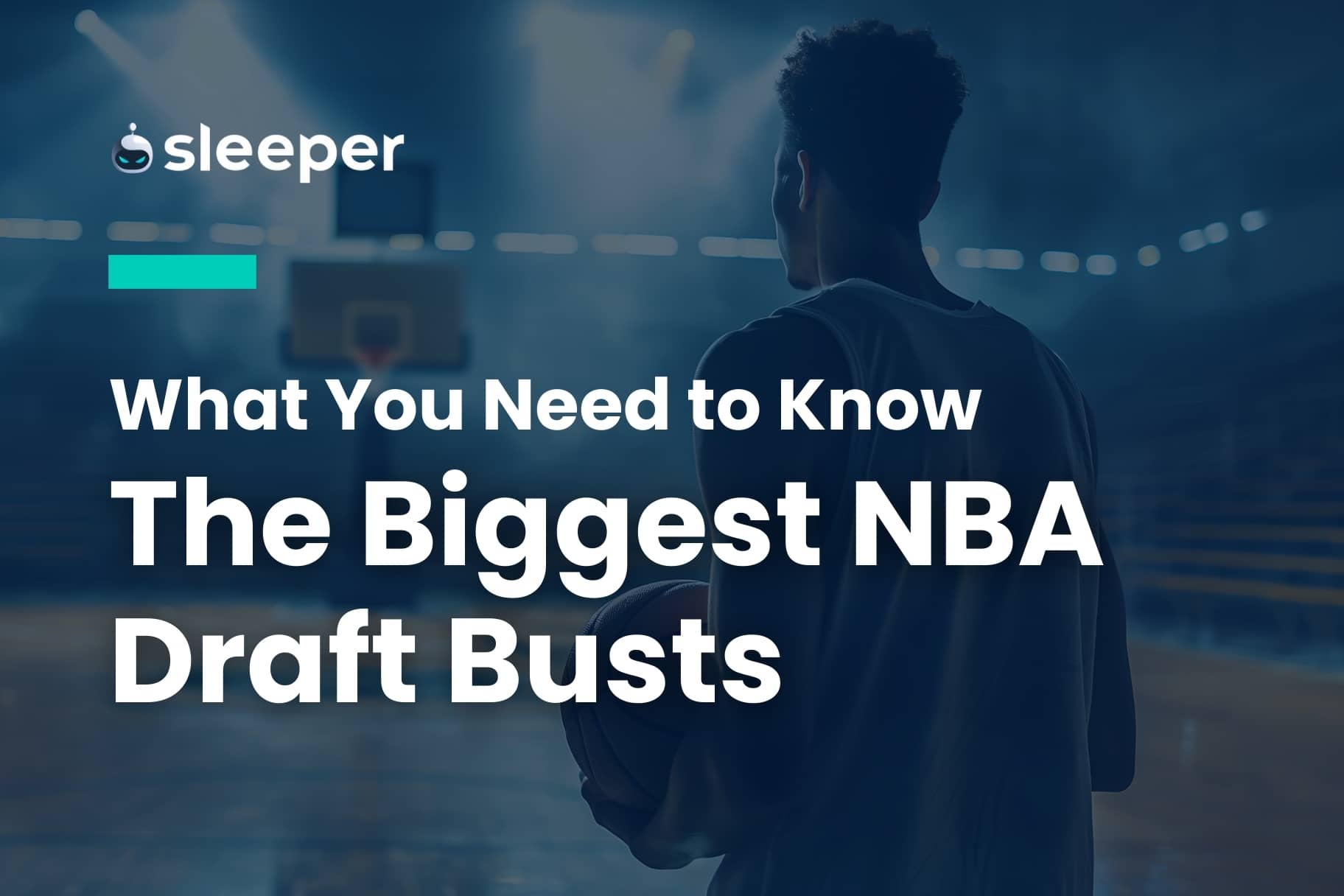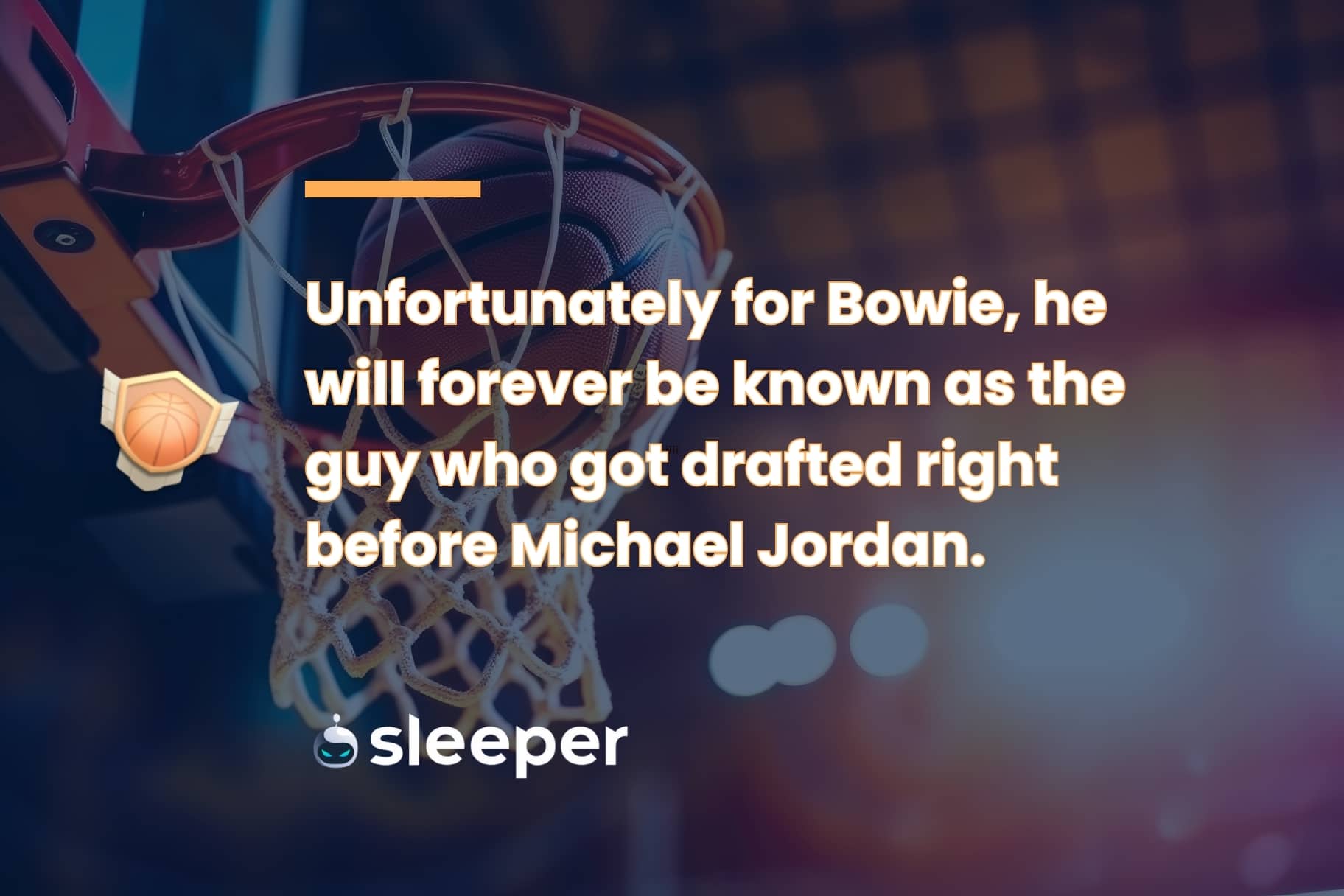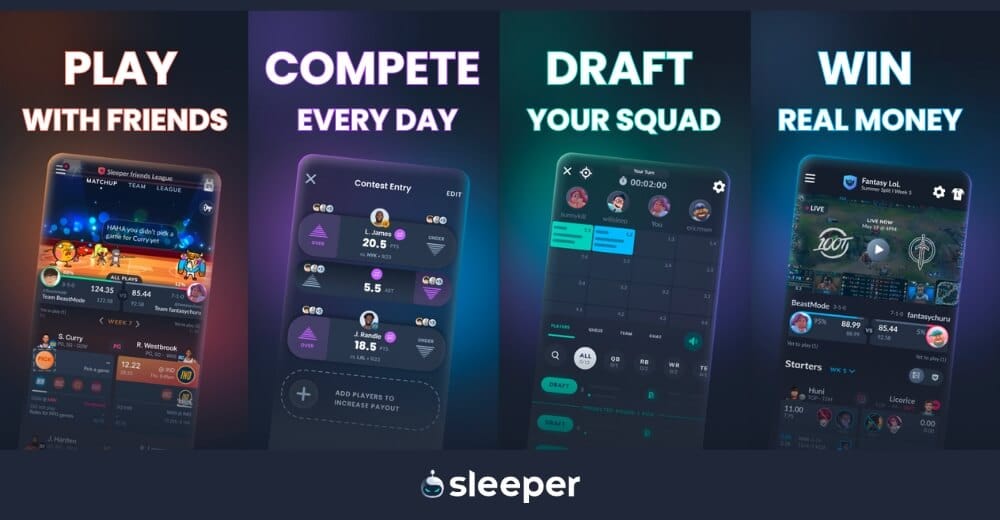From Kwame Brown and Greg Oden to Anthony Bennett and Darko Miličić, we run down the biggest busts in NBA Draft history and why they didn’t pan out.

The Biggest Busts in NBA Draft History: 10 Players Who Didn’t Live Up To the Hype
Some players realize their dream of being selected on draft night and playing in the NBA – but then they aren’t able to live up to the expectations surrounding their selection. Stats and hype may be indicators of potential, but they’re far from guarantees.
Let’s examine the 10 biggest busts in NBA Draft history and why they didn’t pan out.
NBA Draft’s Biggest Flops
1. Kwame Brown
As a senior at Glynn Academy in Georgia, Brown averaged 20.1 points, 13.3 rebounds, 5.8 blocks, 3 assists and 2 steals per game. The Washington Wizards saw enough to select him No. 1 overall in the 2001 NBA Draft, making him the first high school player ever taken with the top pick.
Unfortunately, Brown averaged just 6.6 points and 5.5 rebounds per game for his career, bouncing around to seven NBA teams.
Brown ended up playing 12 seasons in the NBA and earning $64,227,908 as a role player, so his career was a success in that regard.
Still, he ends up on this list because he failed to realize his full potential and live up to pre-draft expectations. It doesn't help that players taken right after him in his draft like Tyson Chandler (No. 2), Pau Gasol (No. 3), Jason Richardson (No. 5), and Shane Battier (No. 6) thrived in the NBA.
2. Anthony Bennett
The Cleveland Cavaliers stunned everyone when they selected Bennett with the No. 1 overall pick in 2013. The UNLV product was very raw and needed time to develop after a one-and-done collegiate career. Other players like Victor Oladipo (No. 2), Otto Porter Jr. (No. 3), and Cody Zeller (No. 4) were perceived as safer options.
Giannis Antetokounmpo (No. 15) was also in Bennett's draft class, although he was viewed as a long-term project and wasn’t in consideration for a top pick at the time.
Bennett played just four seasons in the NBA with four teams. He only appeared in 151 games, averaging 4.4 points and 3.1 rebounds per game. While Bennett last played in an NBA game in 2017, he went on to play in the G League and overseas.
3. Sam Bowie
If you just look at Bowie's stats and resume, he seems like a fine pick. He played 10 seasons in the NBA, averaging 10.9 points, 7.5 rebounds, and 1.8 blocks per game over the course of his career.
Unfortunately for Bowie, he will forever be known as the guy who got drafted right before Michael Jordan.
The Portland Trail Blazers selected Bowie with the No. 2 pick in the 1984 NBA Draft, right before legends like Jordan (No. 3) and Charles Barkley (No. 5). A litany of leg injuries also derailed his career and limited him from reaching his potential.

4. Darko Miličić
Similar to Bowie, Miličić’s bust label mostly comes from the players selected right after him. The Detroit Pistons drafted Miličić with the No. 2 pick in the loaded 2003 draft, meaning he went right before future stars Carmelo Anthony (No. 3), Chris Bosh (No. 4) and Dwyane Wade (No. 5).
This draft class ended up producing nine All-Stars – LeBron James, Anthony, Bosh, Wade, David West, Josh Howard, Chris Kaman, Kyle Korver and Mo Williams – and Miličić was never more than a role player, averaging 6.0 points, 4.2 rebounds, and 1.3 blocks for his career.
But like Brown and Bowie, Miličić ultimately played in double-digit NBA seasons. He also earned $53,393,817 and won a ring as part of the Pistons’ 2004 title team, so it wasn’t all bad for the seven-footer.
5. Adam Morrison
When the Charlotte Bobcats picked Morrison with the No. 3 overall pick in 2006, there were concerns about how his game would translate to the NBA and whether he had much upside since he was already 22. While he had a terrific college career at Gonzaga, he was never more than a role player in the NBA.
Morrison ended up battling a number of injuries and only appeared in 161 games across his three NBA seasons, averaging 7.5 points and 2.1 rebounds while shooting a dreadful 37.3% from the field.
He did walk away with two championship rings as part of Kobe Bryant’s Lakers in 2009 and 2010.
6. Hasheem Thabeet
Like Morrison, there were a lot of questions about how Thabeet’s game would translate to the pros when the Memphis Grizzlies picked him No. 2 overall in 2009. In college, the 7’3” center was a matchup nightmare, averaging 13.6 points, 10.8 rebounds, and 4.2 blocks during his junior year at UConn.
However, in the pros, Thabeet didn't tower over all of his opponents, and he didn’t show the strength necessary to battle NBA centers.
Thabeet played five seasons in the NBA, posting career averages of 2.2 points, 2.7 rebounds, and 0.8 blocks per game. James Harden (No. 3 overall), Stephen Curry (No. 7), and DeMar DeRozan (No. 9) were picked right after Thabeet. Oof.
7. LaRue Martin
As a senior at Loyola, Martin averaged 19.6 points and 15.7 rebounds, which prompted Portland to select him with the No. 1 overall pick in 1972.
Martin was drafted ahead of a trio of Hall-of-Famers: Bob McAdoo (No. 2), Paul Westphal (No. 10), and “Dr. J,” Julius Erving (No. 12).
The 6’11” center played just four seasons in the NBA, averaging 5.3 points and 4.6 rebounds for his career.
8. Greg Oden
Oden was absolutely dominant in high school and college, drawing comparisons to Bill Russell and Shaquille O’Neal, among others. This is why Portland drafted him No. 1 overall in 2007 — ahead of Kevin Durant, who went No. 2.
Unlike most of the other players on this list, Oden was quite productive when he was on the court. During the 2009-10 season, he showed glimpses of brilliance, averaging 11.1 points, 8.5 rebounds, and 2.3 blocks in just 23.9 minutes.
Unfortunately, he just couldn’t stay healthy. Oden was sidelined by injury after injury, and his NBA career came to an end after just 105 games.
9. Michael Olowokandi
The No. 1 overall pick by the Los Angeles Clippers in 1998, "The Kandi Man" failed to live up to expectations, averaging just 8.3 points and 6.8 rebounds per game over the course of his nine-year NBA career.
Three future Hall-of-Famers were drafted shortly after Olowokandi: Vince Carter (No. 5), Dirk Nowitzki (No. 9), and Paul Pierce (No. 10). Mike Bibby (No. 2), Antawn Jamison (No. 4), and Jason Williams (No. 7) also had long, successful careers.
10. Jay Williams
Williams was dominant as a junior at Duke, averaging 21.3 points, 5.3 assists, 3.1 threes, and 2.2 steals per game, and the Chicago Bulls subsequently picked him No. 2 overall in 2002.
Williams became one of the biggest "what ifs" in NBA history as a motorcycle accident ended his career after just 75 games. He fractured his pelvis, severed the femoral artery in his leg, tore his hamstring from the bone and tore his ACL (plus two other ligaments in his knee), among other setbacks.
By riding the motorcycle, Williams violated his contract with the Bulls, who waived him just one year after drafting him. Williams became addicted to painkillers after the crash, but he has since turned his life around to become a prominent basketball analyst at ESPN.
How to Avoid Busts in Fantasy Basketball Drafts
Busts can happen in fantasy basketball, too. Some players with high expectations may be undersized for their position or have some off-court drama, or perhaps they’re just a bad fit – playing style or culture-wise – for the team. Here are some tips to ensure you steer as clear as possible from those in your next draft.
Stay Away From Injury-Prone Players, Especially Early on
In fantasy basketball, availability is the best ability. If a player is injury-prone, it might make sense to avoid him, especially early in the draft. You can chase upside in later rounds, but your top picks need to carry your team. You can't win your fantasy league on draft day, but you certainly can lose it if you load up on players who miss a ton of games.
Avoid Raw Rookies
It’s easy to fall in love with rookies and their untapped potential, especially the ones who heard their name called very early in the NBA Draft. However, many top picks are drafted that high because of their long-term potential, not because they’re ready to contribute immediately. Do your homework on which rookies are NBA-ready and which ones seem like raw projects. Many incoming rookies are teenagers who will have a hard time adjusting to the NBA, so don’t expect them to dominate from a fantasy perspective right out of the gate.
Pay Attention During the Offseason
Some fantasy managers stop paying attention during the summer and then cram once the season is around the corner. If you follow the NBA offseason closely, you’ll have a much better idea of which players are poised to take on an increased role with their new team and which players stand to lose minutes or opportunities due to a recent addition. You don’t want to draft a guy only to realize that he’s been moved to the bench or given a lesser role because of an offseason transaction that you missed.
Don’t Chase Aging Stars’ Past Production
Every year, there are several players who get drafted way too high solely because they’re a recognizable name. Typically, these are aging stars who are being drafted at their ceiling because they’re popular and they’ve been reliable fantasy options for many years. These aging stars come with a lot of risk, though, as they’re more likely to get injured, take games off for rest and show signs of decline.
Further reading: 14 Tips to Dominate in Fantasy Basketball
Frequently Asked Questions
Why are busts more common in the NBA than in other sports?
In the NFL, a player must be three years out of high school in order to be draft-eligible, so front offices get multiple years to evaluate prospects before they enter the draft. In the NBA, teams are often drafting teenagers based on a very small sample size. Before 2006, players were able to enter the NBA directly out of high school, so they were even younger and less proven.
Because a superstar can change a franchise’s fortunes overnight, NBA teams tend to fall in love with potential and draft high-upside, boom-or-bust prospects. They understand the risks and still opt to swing for the fences rather than going with a safer, lower-ceiling pick.
What can teams do to avoid drafting a bust?
The best front offices do extensive homework on each prospect, so they’re able to identify red flags on and off the court. Every team has its own approach to the pre-draft process, but there’s no question that the organizations that are best at gathering intel have a significant advantage.
Also, teams must weigh each prospect’s risk-reward ratio. If a player has an extensive injury history, character issues, poor work ethic, inconsistent play or the wrong people in his inner circle, these can be signs that the player may have a higher probability of becoming a bust.
How Do Players Feel About the ‘Bust’ Label?
Each player may react differently, but Oden discussed the bust label candidly in a 2020 interview to provide some insight.
“Honestly, with the word ‘bust,’ I used to throw it around when talking about myself. I kind of took the power away from it by saying it, like, ‘I might be a bust!’” Oden said. “But that’s somebody else’s personal thought. I had an opportunity and it didn’t work out, which was unfortunate. It didn’t turn out the way that it was supposed to, but I think I was actually one heck of a basketball player back in the day."
Oden continued. “Funny story about that word bust: If you go to YouTube and type in ‘Greg Oden highlight video,’ the best one is actually the one titled ‘Greg Oden: A Bust?’ Go watch that! I’ve watched it. I actually watch it a lot; it makes me feel good about myself! (laughs)”
Despite how their paths diverged, Oden does not harbor any resentment or jealousy toward Durant.
“I’m nothing but a fan of KD,” Oden said. “I had some feelings inside like, ‘Damn, I was picked first… I wish I could be doing those things!’ I wish I could be the businessman that he is, the good dude that he is. But I’ve never felt anger or like, ‘That should be me!’ I’m a fan of basketball and a fan of him. I wish him nothing but the best!”
Bust Out in Fantasy Basketball and DFS
Now that we’ve covered busts in real life and fantasy, you’re ready to take this knowledge into your next fantasy draft.
If you’re interested in starting a fantasy basketball league, Sleeper has you covered! Sleeper offers exclusive features like Lock-In mode, Game-Pick mode, voice and text chat, custom scoring, in-depth notes for research, custom playoff settings, no ads, multi-team trades, every type of league (including keeper and dynasty), weekly league reports, live scoring, each player's transaction history and more.
Not only is Sleeper an excellent platform for season-long fantasy leagues, it’s also a great destination for DFS. With Sleeper Picks, you can multiply your winnings up to 100x with just a few selections, follow live gamecasts and chat with friends as you compete.




